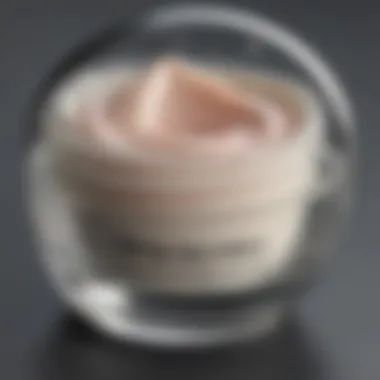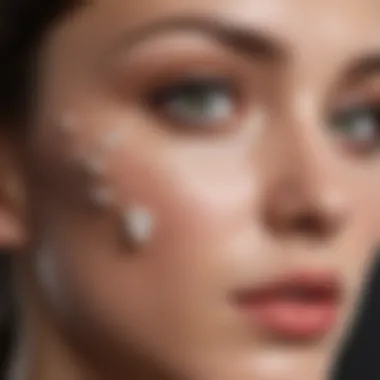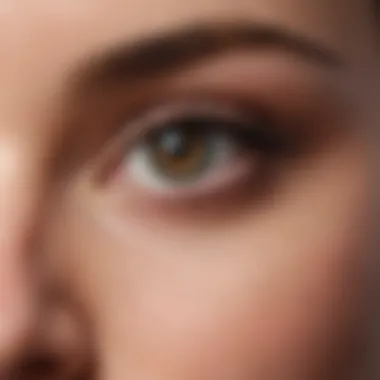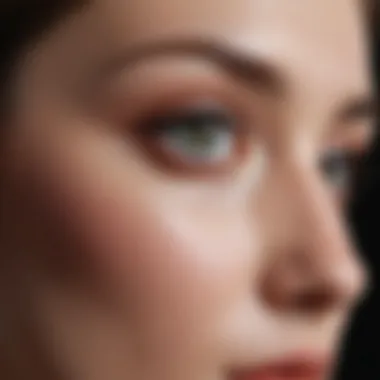Ultimate Guide to Eye Cream for Dry Eyelids


Intro
The skin around our eyes is some of the most delicate on our bodies, particularly the eyelids. They can easily become dry due to various factors, such as environmental conditions, aging, and even some medical conditions. Finding a suitable eye cream specifically for very dry eyelids is essential for maintaining hydration and overall skin health.
Understanding the importance of hydration cannot be overstated. Dry eyelids can lead to discomfort, irritation, and even fine lines, affecting not only appearance but also self-confidence. Thus, the selection of eye creams must focus on ingredients that restore moisture, provide protection, and support skin repair.
In this guide, we will delve into the characteristics of effective eye creams for very dry eyelids. We will investigate the underlying causes of dryness, important hydrating ingredients, and correct application techniques to ensure maximum benefits. By equipping ourselves with this knowledge, we improve our ability to choose the right formulations for our unique skin needs.
Being aware of potential side effects and receiving expert recommendations can further enhance the experience. Let’s explore all these topics in detail.
Understanding Very Dry Eyelids
Dry eyelids can present various issues, and understanding them is crucial for effective treatment. Dryness can lead to discomfort, irritation, and even skin damage if left unaddressed. This section will explore the nature of dry skin around the eyes, common causes, and the implications of ignoring this condition.
Defining Dry Skin Around the Eyes
Dry skin around the eyes may manifest as flakiness, tightness, or redness. The skin in this area is naturally thinner and more delicate than the rest of the face. When moisture levels decrease, it can lead to visible signs of aging, increasing the urgency to maintain proper hydration. Individuals often overlook the specifics of the skin around the eyes, assuming it behaves like the rest of the facial skin. However, it requires specific care due to its unique characteristics.
Common Causes of Dry Eyelids
Dry eyelids can result from multiple factors, some of which may be environmental or related to personal health. Addressing the root cause is necessary for effective treatment.
Environmental Factors
Environmental factors play a significant role in the hydration levels of the skin around the eyes. Low humidity, particularly during the winter months, can strip moisture from the skin. Additionally, prolonged exposure to air conditioning or heating can exacerbate dryness. The skin can react negatively to extreme temperatures or pollutants, leading to irritation. This highlights the importance of environmental awareness in maintaining optimal skin health. While understanding these factors may not provide immediate solutions, awareness is the first step in managing and preventing dryness.
Skin Conditions
Various skin conditions contribute to dry eyelids. Eczema, psoriasis, and blepharitis are common culprits. Eczema often leads to red, itchy patches, while psoriasis can cause flaky scales. Blepharitis, an inflammation of the eyelid margins, can create irritation and dryness. Recognizing these conditions is vital as they require different approaches to treatment. A proper diagnosis ensures that individuals receive the right care, preventing issues from worsening.
Allergies and Irritants
Allergies and irritants are another important factor in dry eyelids. Many people may experience reactions to cosmetic products, skin care ingredients, or environmental allergens such as pollen. Common irritants include fragrances and preservatives found in lotions and makeup. Understanding personal allergies can aid in the selection of appropriate products and ultimately help maintain skin health. Eliminating exposure to recognized irritants is beneficial and often necessary for the skin's well-being.
Aging Process
Aging naturally causes the skin to lose moisture and elasticity. Collagen production declines over time, leading to thinner skin and reduced ability to retain hydration. Dry eyelids in older adults are common, making it vital to incorporate anti-aging strategies into skincare routines. Addressing the aging process is an ongoing effort that focuses on prevention and treatment, promoting healthier skin as one ages.
Through understanding the various aspects of very dry eyelids, readers can better equip themselves to manage and prevent these issues. Knowledge of the underlying causes allows for thoughtful choices in daily routines and product selections.
The Necessity of Eye Creams for Hydration
The delicate skin around the eyes requires specific and targeted care, especially for those dealing with very dry eyelids. Using an eye cream designed for hydration is essential in preserving skin health and enhancing the overall appearance of this sensitive area. Eye creams cater to specific issues, where standard moisturizers may not provide adequate results. Part of the necessity stems from the unique characteristics of the skin around the eyes. This skin is thinner and more vulnerable than facial skin, making it prone to dryness, irritation, and signs of aging.
Consistent moisturization is crucial in maintaining skin barrier function and preventing moisture loss. Eye creams often include ingredients that can significantly improve hydration levels over time. These products not only combat dryness but also assist in minimizing fine lines and wrinkles. Moreover, eye creams help to soothe irritation and reduce inflammation, which are common complaints among individuals with very dry eyelids.


Why Regular Moisturization is Important
Regular moisturizing helps restore and maintain optimal hydration levels in the skin. When eyelids lack moisture, the skin can become flaky, red, or irritated. For people suffering from this condition, regular use of eye cream can rejuvenate and nourish their eyelid skin effectively. It creates a protective layer that retains moisture and helps shield against environmental aggressors.
For best results, hydration should be part of a daily skincare routine. Many people overlook the eye area in their regimen, often using heavier face creams. However, regular application of an eye cream can lead to noticeable improvements in texture and elasticity. It thus becomes a key component in enhancing the health of very dry eyelids.
Difference Between Eye Creams and Regular Moisturizers
While it might seem convenient to use a regular moisturizer for all areas of the face, eye creams are formulated specifically for the more fragile skin around the eyes. Eye creams typically have a lighter consistency, making them suitable for this sensitive area. In contrast, regular moisturizers can contain heavier emollient ingredients that can lead to product buildup or irritation around the eyes.
Eye creams often contain targeted active ingredients, including peptides, antioxidants, and specialized humectants, which are designed to cater precisely to the needs of the skin in this region. The formulation is more likely to prioritize hydration without causing excessive oiliness or clogging pores. Overall, while there is some crossover in the ingredients between the two types of products, their formulations differ significantly to provide optimal care for hydrated and healthy eyelids.
In summary, eye creams play a vital role in maintaining hydration in the delicate skin around the eyes, providing benefits that regular moisturizers may not adequately deliver.
Integrating an eye cream into your daily skincare regime can significantly improve the condition of very dry eyelids. Being aware of the differences in formulations allows users to choose more wisely regarding their specific needs.
Key Ingredients in Eye Creams for Dry Eyelids
In the realm of skincare, particularly when it pertains to the delicate area surrounding the eyes, understanding the key ingredients of eye creams is vital. For those battling very dry eyelids, selecting the right formulation can significantly enhance their quality of life. The right ingredients can provide profound hydration, improving the overall appearance and comfort of the skin.
Humectants
Humectants are agents that attract water. These ingredients play a crucial role in ensuring that moisture is retained within the skin. Glycerin and hyaluronic acid are two popular humectants found in many eye creams. They allow the skin to hold onto moisture from the air, providing ongoing hydration throughout the day. When applied regularly, humectants can plump the skin and reduce the appearance of fine lines, leading to a more youthful look. Given the extremely thin skin around the eyelids, these ingredients are essential in combating dryness.
Emollients
Emollients are substances that soften and smooth the skin. They create a barrier on the skin’s surface, preventing water loss. Common emollients such as shea butter, squalane, and ceramides help restore the skin's natural barrier, which can be compromised due to environmental stressors or aging. Using eye creams with robust emollients will significantly enhance skin texture, providing a velvety finish and diminishing irritation. They are also incredibly beneficial for individuals whose eyelids are prone to scaliness or cracking due to dryness.
Occlusives
Occlusives are heavier agents that coat the skin, acting as a seal to block moisture loss. Petrolatum, beeswax, and dimethicone are examples of occlusive agents frequently featured in eye creams. While they are not always lightweight, their effectiveness cannot be ignored. They create a protective layer that prevents transepidermal water loss, crucial for very dry eyelids. These ingredients are particularly advantageous when applied overnight, allowing for prolonged hydration while the skin is at rest.
Vitamins and Antioxidants
In the realm of eye cream formulations, vitamins and antioxidants are often included to provide additional benefits. Vitamin E and Vitamin C are popular choices, offering protection against free radicals and enhancing skin repair. They not only combat dryness but also improve skin tone and texture, supplying an added layer of defense against environmental stressors like pollution and UV exposure. Incorporating these vitamins can facilitate a healthier appearance over time, ensuring that the eyelids look revitalized and nourished.
"Choosing the right eye cream involves understanding the fundamental ingredients and how they interact with your skin type."
By prioritizing eye creams enriched with humectants, emollients, occlusives, and vital vitamins, individuals suffering from very dry eyelids can curate a skincare routine that not only hydrates but also restores. The mixture of these elements is crucial in maintaining an appropriate moisture balance and promoting overall skin health around the eyes.
Recommended Eye Creams for Very Dry Eyelids
Selecting the right eye cream is vital for individuals dealing with very dry eyelids. This delicate area requires specialized care due to its thin skin. Eye creams formulated for hydration can help restore moisture, improve texture, and protect the skin barrier. Furthermore, the use of appropriate products can lessen the risk of irritation and inflammation. This section will explore various options available in the market, categorized by type and price range, allowing for informed decisions.
Top Brands and Products
When it comes to tackling very dry eyelids, several top brands have earned a reputation for creating effective eye creams. These products often include beneficial ingredients aimed at deep hydration and soothing properties. Some notable products include:


- La Roche-Posay Toleriane Ultra Eye Cream: This product is ideal for sensitive skin and provides intense hydration. Its formulation includes niacinamide, which helps to calm irritation.
- CeraVe Eye Repair Cream: Known for its rich blend of ceramides and hyaluronic acid, this cream helps to restore the skin barrier while providing lasting moisture.
- Clinique Moisture Surge Eye 96-Hour Hydro-Filler Concentrate: This eye cream offers an extended hydration effect, making it perfect for those with very dry eyelids.
Budget-friendly Options
For those seeking effective yet affordable eye creams, several products deliver quality without breaking the bank. Here are some commendable options:
- The Ordinary Caffeine Solution 5% + EGCG: This lightweight solution tackles dryness while helping to reduce puffiness and dark circles at a great price point.
- Neutrogena Hydro Boost Gel-Cream for Eyes: Enriched with hyaluronic acid, this gel-cream provides refreshing hydration and has a smooth texture.
- Eucerin Advanced Repair Cream: Although not traditional eye cream, this formula can work around the eye area, providing deep moisture and protection against dry skin.
Luxurious Choices
For those willing to invest more in their skincare, luxurious choices often include high-quality formulations that focus on rejuvenation and extensive hydration. Examples are:
- SkinCeuticals A.G.E. Eye Complex: This product targets signs of aging while hydrating; it is known for its rich formulation and effective results.
- Tata Harper Restorative Eye Cream: This luxurious cream features natural ingredients and aims to enhance moisture levels while soothing the skin.
- Sisley Paris Eye Contour Mask: While technically a mask, this product provides a significant moisture boost, making it ideal for treatments on very dry eyelids.
Always choose eye creams that specifically mention compatibility with sensitive skin to avoid any adverse reactions.
Choosing the right eye cream can profoundly impact skin health around the eyes. Not only does it help to manage dryness, but it can also enhance overall appearance. Finding the right product according to one's need and budget is key.
Application Techniques for Optimal Results
Application techniques significantly influence the efficacy of eye creams, especially for individuals with very dry eyelids. Using the right method not only ensures the product penetrates the skin effectively but also prevents unnecessary irritation. Proper application techniques also enhance absorption, making sure that skin receives the full benefits of the active ingredients.
When applying eye cream, gentle motions are crucial. This area is sensitive; thus, a light hand can help prevent tugging on the skin. Additionally, understanding the right timing and frequency can optimize results, further enhancing hydration in the eyelids. With this in mind, let's explore how to apply eye cream properly and how often to do so for the best outcomes.
How to Apply Eye Cream
Applying eye cream requires a careful approach. Here’s a step-by-step guide to help you achieve optimal results:
- Cleanse Your Face: Start with a fresh, clean face. Use a gentle cleanser that suits your skin type.
- Pat Dry: After washing, pat your face dry with a soft towel, avoiding vigorous rubbing around the eyes.
- Dispense a Small Amount: Use a pea-sized amount of eye cream. When it comes to skincare, more product does not always equal better results.
- Use Your Ring Finger: The ring finger applies the least pressure. Gently dab the cream around the orbital bone, avoiding direct contact with the eye.
- Employ a Tapping Motion: Rather than rubbing, use a light tapping motion. This technique encourages absorption without stressing the skin.
- Move from the Inner to the Outer Corner: Start at the inner corner of the eyelid and move towards the outer corner. Ensure an even application covering the entire area.
- Be Mindful of Excess Product: If excess cream is present, gently remove it with a soft tissue to prevent irritation.
This method allows for effective delivery of moisture and nutrients, crucial for managing very dry eyelids.
Frequency of Application
The frequency of eye cream application can vary based on individual needs and the product formulation. Generally, a consistent routine yields the best results. Here are some guidelines to consider:
- Twice a Day: For most people, applying eye cream in the morning and evening is sufficient. This ensures continuous hydration, especially crucial for dry skin types.
- Follow Product Instructions: Always check the specific instructions on the product label. Some formulations might recommend different frequencies based on their potency.
- Adjust Based on Needs: If your eyelids feel particularly dry or irritated, consider adding an extra application during the day. It is essential to respond to the skin’s signals.
"Regular application fosters skin resilience, so don't skip it even when the skin feels better."
Finding a balance in the frequency can help maintain moisture levels, ensuring the skin remains supple and hydrated.
By keeping standard application techniques and frequency in mind, individuals can maximize the benefits of their eye cream, specifically tailored for very dry eyelids. Consistency is key, and with a little patience, noticeable improvements can be achieved.
Potential Side Effects and Precautions
Understanding potential side effects and necessary precautions is crucial when using eye creams, especially for individuals with very dry eyelids. Hydration is a primary goal, yet, not all products will provide the desired effect without possible reactions. An informed choice can prevent discomfort and ensure optimal skin health. Knowing how to identify adverse reactions and effectively patch test products will contribute significantly to a positive skincare experience.


Common Reactions
When integrating a new eye cream into a skincare routine, some users might encounter common reactions. These can vary based on ingredients, personal skin sensitivities, and underlying conditions. Typical reactions may include:
- Redness: This is a sign of irritation. Both mild and severe reactions can present in various forms.
- Itching: Often linked to allergens or strong fragrances in the formulation.
- Swelling: Puffiness can occur if the skin is sensitive or reacts negatively to a component in the cream.
- Dryness or Flaking: Paradoxically, some eye creams may exacerbate dryness due to harsh ingredients.
Not all reactions indicate a long-term adverse effect, but recognizing them allows for prompt action. If symptoms persist, it is advisable to discontinue use and consult a dermatologist.
How to Patch Test
Conducting a patch test can help ascertain how the skin will react to a new eye cream, minimizing risk before full application. Here’s how to perform an effective patch test:
- Cleanse the Skin: Start with a small area of skin around your wrist or behind your ear. Cleanse this area thoroughly to avoid any interference from other products.
- Apply a Small Amount: Using your fingertip, apply a pea-sized amount of the eye cream to the test area. The skin here is sensitive, mirroring the eyelid’s characteristics.
- Observe for 24 Hours: Allow the cream to remain on the skin without washing it off. Monitor for any signs of redness, itching, or swelling.
- Re-evaluate: If there are no adverse reactions after 24 hours, it is generally safe to try the cream on your eyelids. However, if issues arise, discard the product immediately.
“Patch testing is a proactive step in skincare. It helps avoid discomfort and ensures skin compatibility.”
Being proactive in recognizing potential side effects and performing patch tests can enhance the effectiveness of eye creams while safeguarding skin health. Knowledge in managing these reactions elevates users' confidence in their skincare routines.
Expert Tips for Managing Dry Eyelids
Managing very dry eyelids requires a combination of effective skincare routines and lifestyle adjustments. These tips not only help in alleviating dryness but also in maintaining the health of the delicate skin around the eyes. Understanding how lifestyle influences skin health will empower readers to make informed decisions, ensuring a holistic approach to eye care.
Lifestyle Changes for Better Skin Health
Adopting certain lifestyle changes can greatly enhance skin health around the eyes. Here are some key adjustments that can be made:
- Hydration: Adequate water intake is critical. Hydration affects skin elasticity and moisture levels. Aim for at least eight glasses of water daily.
- Balanced Diet: Incorporating foods rich in vitamins A, C, and E, as well as omega-3 fatty acids, can benefit skin health. Leafy greens, nuts, fish, and fruits should be integral parts of the diet.
- Avoiding Irritants: Products with heavy fragrances or alcohol can exacerbate dry eyelids. Choose gentle, hypoallergenic alternatives.
- Sun Protection: UV rays can damage the skin around the eyes. Use a broad-spectrum sunscreen and wear sunglasses when outdoors to protect against sunlight.
- Adequate Sleep: Lack of rest can affect skin appearance and moisture levels. Aim for 7 to 9 hours of quality sleep per night.
By integrating these lifestyle changes, individuals can create a solid foundation for eye care, supporting overall skin health.
Consultation with Dermatologists
Regular consultations with dermatologists are vital. A dermatologist can provide personalized advice based on specific conditions or sensitivities. Several reasons highlight the importance of professional consultations:
- Identifying Underlying Issues: A dermatologist can diagnose conditions that contribute to dry eyelids, such as eczema or blepharitis.
- Tailored Treatments: With expert knowledge of skin types and common irritants, dermatologists can recommend suitable eye creams and skincare products.
- Preventive Measures: Professionals can guide on what to avoid in daily routines that might aggravate skin issues. This helps in minimizing long-term damage.
- Monitor Progress: Periodic check-ups allow dermatologists to assess how well the current regimen is working and suggest adjustments if needed.
Overall, consultations enable a proactive approach to managing skin health, ensuring long-term management of very dry eyelids.
Finale
In summary, understanding how to care for very dry eyelids is crucial for maintaining both skin health and overall comfort. This article underscores the significance of hydration, effective eye creams, and correct application techniques tailored for this delicate area.
Choosing the right eye cream is not simply about hydration; it is about selecting formulations that cater specifically to one's unique skin circumstances. Ingredients like humectants, emollients, and occlusives play distinct roles in providing moisture and protection. Recognizing these factors can lead to informed decisions when selecting products.
The health of the skin around the eyes reflects overall skin care habits, making it essential to incorporate appropriate eye creams into one's routine. Additionally, the guidance offered by dermatologists or other experts should not be overlooked. Consultation can lead to personalized recommendations that may resolve specific concerns or conditions.
Toying with the idea of recommended products provides a range of options suited for various budgets. Understanding potential side effects and how to address them ensures that care routines are both safe and effective.
Regular application of the right products, coupled with expert tips on lifestyle changes, can vastly improve the condition of very dry eyelids over time. Ultimately, being proactive about eye care reinforces a forward-thinking approach to skin health, making this discussion not just relevant, but profoundly necessary.
The journey to better skin health around the eyes starts with informed choices and consistent care.
Engaging with this topic and its detail can empower beauty enthusiasts, makeup lovers, and skincare aficionados. The collective wisdom encapsulated in this guide serves as a resource for achieving optimal skin health in a region as sensitive as the eyelids.







